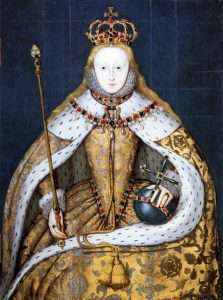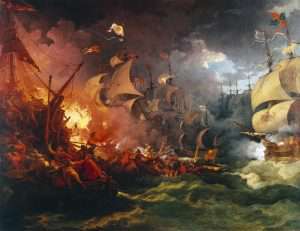by Greta Gebhard, dramaturg
Elizabeth I of England. It seems that throughout history and the hundreds of portrayals of this queen, no one can really seem to agree on who she really is. Even the portrayal of Elizabeth in BYU's production of Mary Stuart will be different than one done 20 years ago or 20 years in the future. This post is going to break down some different points in Elizabeth’s life, and hopefully, come out with a better understanding of this queen that history remembers.

Queen Elizabeth I’s story begins long before she was actually born on September 7, 1533 in Greenwich England. See, her father, King Henry VIII had been married to Queen Katherine of Aragon for almost 20 years, and they had one daughter, Mary, together. Upon realizing that she would never bear him a male heir, Henry decided to do everything in his power to assure the continuation of his line. After a failed attempt to annul the marriage, Henry proclaimed himself head of the Church of England and Wales in 1531. Two years later, he secretly married Anne Boleyn, Elizabeth’s mother, and Anne was crowned queen at the end of May.
Elizabeth’s birth created quite a stir since many viewed Henry’s marriage to Anne as illegal therefore making Elizabeth an illegitimate child. At first, she was treated exactly like a princess. But things went downhill when her mother was executed for treason, adultery, and incest in 1536. Henry married Jane Seymour quickly after that, and Elizabeth went from being a princess to a lady to a declared bastard by her own father.

In 1537, Elizabeth was moved to Hatfield House, where she spent most of her childhood. She watched as her father’s wives and love interests came and went. Jane Seymour died giving birth to Edward VI, Anne of Cleves was too ugly and quickly divorced, and Katherine Howard was executed after her affair was uncovered. Henry married his last wife, Katherine Parr, in 1543, and they stayed married, supposedly contentedly, until he died in 1547.
Katherine took an especial interest in Henry’s children, and she had the strongest impact on Elizabeth’s life. Katherine arranged for the best tutors to educate both Elizabeth and Edward, thus making her as educated as any other royal prince. Elizabeth developed a persona of being a serious person who always carried a book with her. She usually dressed in white or black and with a simplicity that was absent in the typical Tudor court.

After Henry’s death, the line of succession went to Edward VI, his son from Jane. Edward had been born prematurely and had always been a rather sickly child. His uncle, Lord Protectorate Edward Seymour, acted as the 10-year old’s regent. During his reign, the care of Elizabeth was given to different courtiers, usually further away from the king’s court. These formative years of Elizabeth dealt her with several creepy suitors, older men who saw the potential she had to gain power at the court. Elizabeth proved her intelligence and wit by avoiding all promises and insinuations coming from those who wanted to displace her.
Edward died in 1553, and his advisors tried to keep the monarchy in Protestantism by placing Lady Jane Grey and her husband, Lord Guilford Dudley on the throne ahead of Elizabeth and her older sister, Mary. Jane’s reign only lasted 9 days before the supporters of Mary joined together to take back her throne. Jane and her husband were executed, and Elizabeth spent the entirety of Mary’s reign feigning Catholicism and flying under the radar.

Mary struggled to maintain control of the kingdom, especially with the division of religions throughout the kingdom. She earned the nickname “Bloody Mary” because of her extreme persecution of all people adhering to the Protestant faith. She made matters worse when she decided to marry King Philip II of Spain in an attempt to return the country to Catholicism. Even the Catholics in England felt antagonism towards Spain and wished to avoid that union. Rumors abounded that Elizabeth wanted to displace Mary, and the paranoid queen had Elizabeth sent to the Tower of London. Elizabeth refused to enter the tower, delaying twice before being forced to go inside. She only spent two months inside the tower before being released, but it was one of the most trying periods of her childhood. It was luckily King Philip who had the good sense to set Elizabeth free. He understood the complicated nature of religion and politics in England, and before his arrival, he asked Mary to release Elizabeth.
Although released from the Tower of London, Elizabeth was essentially imprisoned in a small countryside manor. Elizabeth spent over a year here, writing letters to her half-sister in an attempt to regain the freedom she felt she deserved. Finally, when Mary was pregnant, she allowed Elizabeth to return to court and granted her freedom. Mary’s reign had always been a bit rough, and things got worse when it was discovered that she was not actually pregnant. Soon thereafter, Philip returned to Spain, perhaps having realized that Mary would never bear children. From that point on, it was simply a waiting game for Elizabeth until she took the throne. Mary Died in November 1558 thus leading to Elizabeth’s succession. ]

Elizabeth’s coronation took place on January 15, 1559 in Westminster Abbey. Her people were supportive and excited for this new chapter, but they were also nervous what would happen with the switch from Catholicism to Protestantism. Elizabeth proved to be kind and pragmatic when it came to religion. She officially created a new Protestant church in England and named herself as the leader, but kept many Catholic elements in ceremonies and titles, and she carried a cross for the rest of her life.
Elizabeth was questioned her whole life about marriage. Many nations vied for her hand, but she turned them all down. Some people speculate that her experiences in adolescence with men trying to marry her turned off the whole idea. Others suggest that she knew she was infertile, and couldn’t be bothered to try for children that wouldn’t come. Regardless of those rumors, it is well known that she was in love with a childhood friend, Robert Dudley. He was considered too lowly for the queen, and it would complicate politics in England, not to mention the fact that he was married. Dudley’s wife, Amy Robsart was quite sick and in September 1560, she was found dead at the bottom of the stairs in her house. Rumors abounded that Dudley had killed her in order to marry the queen, thus sealing their fate to never be married, although that did not stop them from being together, or his being named her favorite. She raised him to be the Earl of Leicester in 1564.

Although Schiller’s production of Mary Stuart shows Leicester having a passionate love for Mary, history does not show him so. He apparently loved Elizabeth in return and served her as best he could. Perhaps his closest form of betrayal was his remarriage to Lettice Knollys in 1578, which Elizabeth took particularly hard. She hated Lettice for the rest of her life, but still kept Dudley close to herself.
Elizabeth never named an heir for she knew the figurehead that an heir could become. The biggest threat was Mary, Queen of Scots. Mary was Elizabeth’s first cousin once removed, and to the people who truly believed that Elizabeth was a bastard, saw Mary as the rightful ruler of England, not to mention that she was a Catholic. As the Scottish government came crashing down around Mary in 1568, she decided to flee to England and ask for support from her cousin in regaining her throne. Elizabeth and her advisors chose instead to imprison her and keep her captive for the next 19 years.

Several plots to assassinate Elizabeth were uncovered during Mary’s imprisonment. The closest one was called the Babington Plot, and Mary herself was suggested as writing letters to some of the conspirators. This opened the door for her subsequent trial and execution. Although Elizabeth claims to have signed the execution order but did not want it handed over, many historians have wondered about her sincerity. Regardless of her intent, Mary was executed on February 8, 1587 at Fotheringhay Castle.
Elizabeth did her best to stay out of any major conflicts. She focused her attention on her own people and tried to talk peace whenever possible, and at times, defying the advice of her councilors. The most unavoidable time came with Spain. Sir Francis Drake, the privateer, had been ambushing Spanish ships for many years, indirectly ordered to do so by the crown. Finally, Philip, once the husband of Mary I of England, decided he had had enough. The Spanish Armada launched on July 12, 1588 to England, and was most forcibly defeated by the weather. Bad tides, timing, and wind led to the destruction of most of the fleet, with a little help from the English fire ships. This battle shows the transition of global power from Spain to England as England became the dominant power at sea and began colonizing across the world.

Elizabeth is well known for the literary period that expanded during her reign. Music, paintings, theatre, and writing were all heavily patronized by the queen, and it led to some great artists like Christopher Marlowe, William Shakespeare, and Hans Holbein. As Elizabeth aged, she switched the style of her portraiture and focused on metaphors, such as portraying herself as a youthful Faerie Queen or some other youthful icon. A bout of smallpox left her face rather deformed, and she used cosmetics and wigs to cover up those blemishes.
Her later reign led to some struggles as she disbanded Parliament for their insistence that she name and an heir, and instead of asking for money from the ruling people, she sold monopolies to the nobility to support her lifestyle, which took advantage of the public. It was during this struggling time that Elizabeth’s health started to deteriorate. Finally, on March 4, 1603, after 44 years on the throne, Elizabeth passed away. After her death, the nation’s leaders went to work securing the throne for James VI of Scotland, the son of Mary, Queen of Scots, whom Elizabeth had executed years prior. He eventually became James I of England, the one who called for a new translation of the Bible commonly referred to as the King James’ Bible.
Although Elizabeth is known across the world for her style, her patronage, and her refusal to be married, it is important for us to consider the whole of her. Nobody can perfectly rule their nation, and she made her own mistakes, had her own periods of mourning and sadness, and loved just the same as you or I. So hopefully when you have the chance to Schiller’s interpretation of her story, you will be able to see past the queen and see the woman who is hidden beneath the crown.


